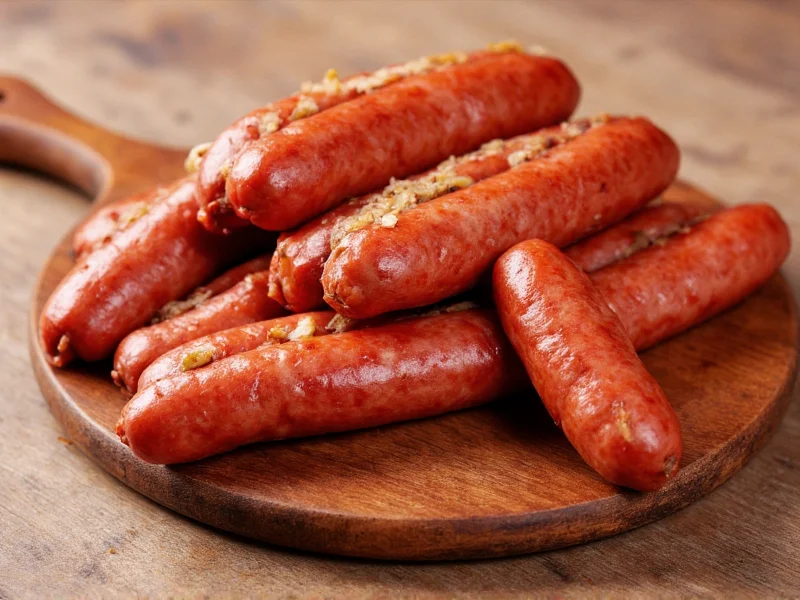What Makes Calabrese Sausage Unique
Authentic Calabrese sausage represents centuries of Italian culinary tradition from the Calabria region. This distinctive sausage features coarsely ground pork shoulder with visible fat marbling, seasoned primarily with peperoncino (Calabrian chili peppers), black pepper, salt, garlic, and often red wine. The specific variety of chili peppers used—typically the diavolicchio variety—gives Calabrese its signature heat that ranges from medium to hot but always maintains a fruity undertone.
Unlike many commercial sausages that rely on liquid smoke or artificial flavorings, traditional Calabrese sausage develops its complex flavor through natural fermentation and air-drying processes. Most authentic versions contain no fillers or preservatives, adhering to strict regional production standards that have been passed down through generations.
Calabrese Sausage vs. Similar Italian Sausages
Many people confuse Calabrese sausage with other Italian pork products. Understanding these differences helps you select the right ingredient for your recipes.
| Sausage Type | Region of Origin | Key Ingredients | Heat Level | Texture |
|---|---|---|---|---|
| Calabrese | Calabria, Southern Italy | Calabrian chilies, garlic, wine | Medium-Hot | Fine to medium grind, firm when cooked |
| Ndjuja | Calabria, Southern Italy | Calabrian chilies, pork fat | Hot | Spreadable paste |
| Soppressata | Multiple regions | Coarse black pepper, wine | Mild to Medium | Coarse grind, firm texture |
| Finocchiona | Tuscany | Fennel seeds | Mild | Coarse grind, firm texture |
Traditional Preparation Methods
Authentic Calabrese sausage preparation follows time-honored techniques that significantly impact flavor development. Traditional producers use natural casings (usually pork intestine) and avoid synthetic preservatives. The sausage mixture undergoes a brief fermentation period before being stuffed, which develops complex flavors through natural bacterial action.
Two primary preparation styles exist:
- Raw (Cruda) - Fresh sausage meant for immediate cooking, typically consumed within days of preparation
- Cured (Stagionata) - Air-dried for several weeks, developing concentrated flavors and firmer texture
When shopping for authentic Calabrese sausage, look for products labeled 'salsiccia Calabrese' with minimal ingredients. Many American versions labeled as 'Calabrese' actually contain additional spices like fennel that would never appear in authentic regional preparations.
Perfect Cooking Techniques for Calabrese Sausage
How to cook Calabrese sausage properly makes all the difference in your final dish. Unlike pre-cooked sausages, authentic Calabrese requires careful attention to cooking time and temperature.
For whole sausages, the ideal method involves:
- Pricking the casing in several places with a fork to prevent bursting
- Starting in a cold pan with minimal oil (the sausage releases its own fat)
- Cooking over medium-low heat for 15-20 minutes, turning frequently
- Finishing with a quick sear over higher heat for caramelization
When using Calabrese sausage in sauces or pasta dishes, remove the casing before crumbling the sausage into the pan. The rendered fat creates an excellent base for tomato sauces, infusing them with spicy, meaty flavor. For calabrese sausage pasta recipes, pair with robust ingredients like broccoli rabe, red peppers, or hearty greens that can stand up to the sausage's bold flavor.
Nutritional Profile and Storage Tips
Understanding calabrese sausage nutritional facts helps incorporate it into balanced meals. A typical 3-ounce serving contains approximately:
- 250-300 calories
- 20-25g fat (primarily saturated)
- 15-18g protein
- Negligible carbohydrates
- Good source of vitamin B12 and iron
For proper storage, keep fresh Calabrese sausage in its original packaging in the coldest part of your refrigerator for up to 3 days. If you've removed it from packaging, wrap tightly in parchment paper followed by plastic wrap. For longer storage, freeze portions in airtight containers for up to 3 months. Thaw frozen sausage in the refrigerator overnight before cooking—never at room temperature.
Classic Calabrese Sausage Recipe Ideas
Authentic calabrese sausage recipe applications showcase its versatility in Italian cuisine. Try these traditional preparations:
Calabrese Sausage and Pasta 'Alla Norma'
While traditionally made with eggplant, this Sicilian classic welcomes Calabrese sausage for added depth. Sauté crumbled sausage with garlic and chili flakes, then combine with roasted eggplant, tomato sauce, and fresh basil. Toss with rigatoni and finish with ricotta salata.
Spicy Calabrese Sausage and Broccoli Rabe
A classic southern Italian combination. Blanch broccoli rabe briefly, then sauté with sliced Calabrese sausage, garlic, and red pepper flakes. Finish with a splash of white wine and serve over crusty bread or with orecchiette pasta.
Calabrese Sausage Stuffed Peppers
For a hearty meal, mix cooked Calabrese sausage with cooked rice, pine nuts, raisins, and pecorino. Stuff into bell peppers and bake until tender. This dish beautifully balances the sausage's heat with sweet peppers and subtle sweetness from raisins.
Avoiding Common Calabrese Sausage Mistakes
Many home cooks make these errors when preparing calabrese sausage:
- Overcooking - Leads to dry, tough texture; remove from heat when internal temperature reaches 160°F
- Using high heat - Causes casing to burst and uneven cooking
- Skipping the resting period - Let cooked sausages rest 5 minutes before slicing
- Pairing with delicate ingredients - Calabrese's bold flavor overwhelms subtle components
When substituting Calabrese sausage in recipes calling for milder sausages, reduce the amount by 25-30% to account for its more intense flavor profile. For those sensitive to heat, remove some seeds from the Calabrian chilies before preparation, but never eliminate them completely—that would sacrifice the sausage's defining characteristic.











 浙公网安备
33010002000092号
浙公网安备
33010002000092号 浙B2-20120091-4
浙B2-20120091-4